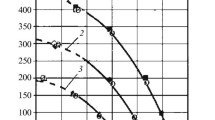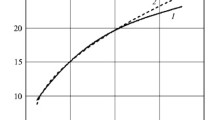A method for modeling the electric glass melting process, which allows obtaining information about the commonality of electric and thermal processes occurring in the glass mass inside an electric glass-melting furnace, has been developed. The melting tank of the furnace is made of electrically conductive chromium oxide. The study was performed by way of modeling using an EHDA integrator, which resulted in the construction of two versions of pilot electric furnaces with different orientation of the electric field lines and a pilot-commercial furnace capable of melting 7 t/day of E-glass, widely used in the fiberglass manufacturing.







Similar content being viewed by others
References
N. N. Shustrov, Yu. N. Pistsov, and B. N. Krasilshchikov, “Electric melting of magnesium aluminate glass,” in: Physicochemical processes and glass melting equipment for fiberglass production, VNIISPV, Moscow (1979), pp. 63 – 75.
Ya. Stanek, Electric Glass Melting [in Russian], Legkaya Industriya, Moscow (1979).
T. N. Trunova and L. A. Bakhvalov, “Calculation of electrical resistivity of glass melts,” Steklo i Keramika, No. 1, 11 – 12 (1981).
O. N. Popov and V. P. Frolova, “Fusion-cast chromia-alumina-zirconia refractories service in industrial glass-melting furnaces,” In: Research in the field of refractories in industrial glass-melting furnaces, GIS, Moscow (1984), pp. 59 – 66.
I. M. Tetelbau, Electrical Modeling [in Russian], Energiya, Moscow (1963).
Ye. V. Degtyareva, I. G. Orlova, Yu. I. Kolosov, and Yu. N. Pistsov, “New refractories for the glass furnaces of the glass-fiber sector,” Refractories, 18(9/10), 610 – 616 (1977).
N. N. Shustrov, V. G. Puzach, and S. A. Bezenkov, “Experience of using chromium oxide materials in electric glass-melting furnaces,” Refract. Ind. Ceram., 59(5), 441 – 444 (2018).
M. T. Matveevich, Magnetic Flux and its Transformation [in Russian], Izd. AN SSSR (1946).
Author information
Authors and Affiliations
Corresponding author
Additional information
Translated from Novye Ogneupory, No. 4, pp. 13 – 18, April, 2020.
Rights and permissions
About this article
Cite this article
Shustrov, N.N., Puzach, V.G. & Bezenkov, S.A. The Effect of the Conductive Walls of the Melting Tank of an Electric Furnace on the Distribution of Energy Flows. Refract Ind Ceram 61, 144–149 (2020). https://doi.org/10.1007/s11148-020-00446-8
Received:
Published:
Issue Date:
DOI: https://doi.org/10.1007/s11148-020-00446-8




